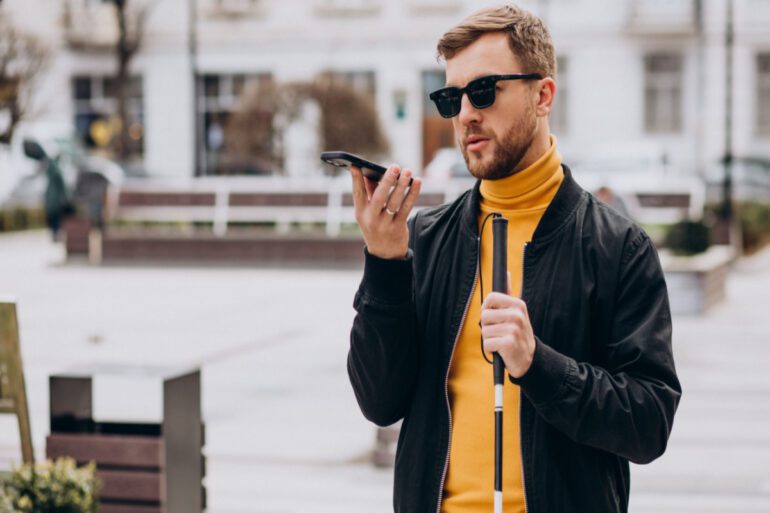TL;DR:
- Hugo Furtado, a Portuguese entrepreneur, has developed waveOut, an augmented reality application for the blind and visually impaired.
- WaveOut utilizes sound navigation and 3D audio to help users locate themselves along a chosen route.
- The application incorporates virtual way-points visible on the phone’s screen, aiding users who cannot read maps.
- Advanced software filters replicate the auditory sensation influenced by the shape of human ears, enhancing spatial orientation.
- Computer vision is integrated to identify safe areas for navigation, and machine-learning models recognize elements like street signs.
- Dreamwaves, the company behind waveOut, aims to integrate with traffic management systems for improved journey experiences.
- Strategic partnerships with companies like Yunex Traffic and retailers such as IKEA present monetization opportunities.
- The application has the potential to revolutionize accessibility and empower the blind and partially sighted in everyday environments.
Main AI News:
In a world where technology constantly pushes the boundaries of innovation, one Portuguese entrepreneur is making waves with an astounding claim: “See the world through your ears.” Meet Hugo Furtado, a visionary based in Vienna, holding a doctorate in augmented reality for minimally invasive cardiac surgery and the founder of Dreamwaves. Furtado’s groundbreaking creation, waveOut, is an augmented reality application poised to revolutionize the lives of the blind and visually impaired.
Drawing from his extensive experience in sound engineering, Furtado embarked on a mission to develop a technology that would empower those struggling with mobility to navigate the world with ease. “We all rely on sound to orient ourselves,” explains Furtado, who presented his remarkable application at the prestigious ChangeNow trade fair. At the core of waveOut lies a sophisticated sound navigation system. Users select their desired itinerary and mark virtual ‘way-points,’ emitting immersive 3D audio that enables them to precisely locate their position as they traverse the chosen route.
Unlike other augmented reality solutions, waveOut liberates users from the need to constantly hold up their phone cameras. Furtado acknowledges that this approach may sacrifice some precision, but it unquestionably offers a superior user experience. To replicate the auditory sensation influenced by the unique shape of human ears, Dreamwaves has developed advanced software filters, allowing individuals to effectively orient themselves in space through sound.
These virtual way-points are also visible on the phone’s screen, serving as a valuable aid for children who cannot read maps or individuals with partial sight. If a user takes a wrong turn, the sound from the nearest way-point temporarily ceases before resuming at the next intersection, effortlessly guiding them back onto the correct path. Dreamwaves’ dedicated team conducted rigorous experiments to understand how humans perceive 3D sound and our remarkable ability to locate ourselves in space. By replicating the acoustic experience shaped by the anatomy of our ears and heads, the application delivers an intuitive and immersive journey for its users.
Embracing a holistic approach, Dreamwaves incorporates computer vision into its design to assist individuals with visual impairments. To activate this feature, users can either hold their smartphones or wear them around their necks. Instead of simply detecting obstacles and warning users of where they shouldn’t go, waveOut focuses on identifying safe areas for navigation. Furtado emphasizes that camera usage is only temporary, providing a practical example: “If you find yourself in a square, unaware of a missed turn and lacking a reference point, you can use your phone’s camera to guide yourself out before stowing it away.”
Dreamwaves leverages cutting-edge machine-learning segmentation directly on smartphones, delivering a fluid computer-vision experience. The application’s models have been trained to recognize specific elements, including street signs and pedestrian crossings, further enhancing the user’s navigation capabilities.
Looking ahead, Dreamwaves aims to integrate seamlessly into urban environments, forging a partnership with Yunex Traffic, a subsidiary of Siemens, in the Netherlands. This collaboration enables waveOut to connect with traffic-light management systems, empowering users to request priority when crossing junctions. For bicycle couriers, this functionality optimizes their delivery experience by anticipating traffic lights, ensuring a more fluid journey with fewer interruptions.
While Dreamwaves intends to offer its technology to private individuals, it also seeks monetization opportunities through strategic partnerships, including courier companies and renowned retailers like IKEA. By facilitating the navigation of the blind and partially sighted inside stores, Dreamwaves aims to revolutionize accessibility in everyday environments.
Hugo Furtado’s unwavering commitment to empowering the visually impaired with groundbreaking technology has the potential to transform lives and create a more inclusive society. With waveOut, individuals can embark on their journeys with confidence, experiencing the world through their ears and embracing newfound freedom.
Conlcusion:
WaveOut represents a significant breakthrough in augmented reality technology for the visually impaired. By leveraging sound navigation, advanced software filters, and computer vision, this application revolutionizes how individuals with visual impairments navigate their surroundings. The integration with traffic management systems and potential partnerships opens up new market opportunities, enabling enhanced accessibility and improved user experiences. The market for assistive technologies is poised for growth, with waveOut leading the way in transforming the lives of the blind and visually impaired.

